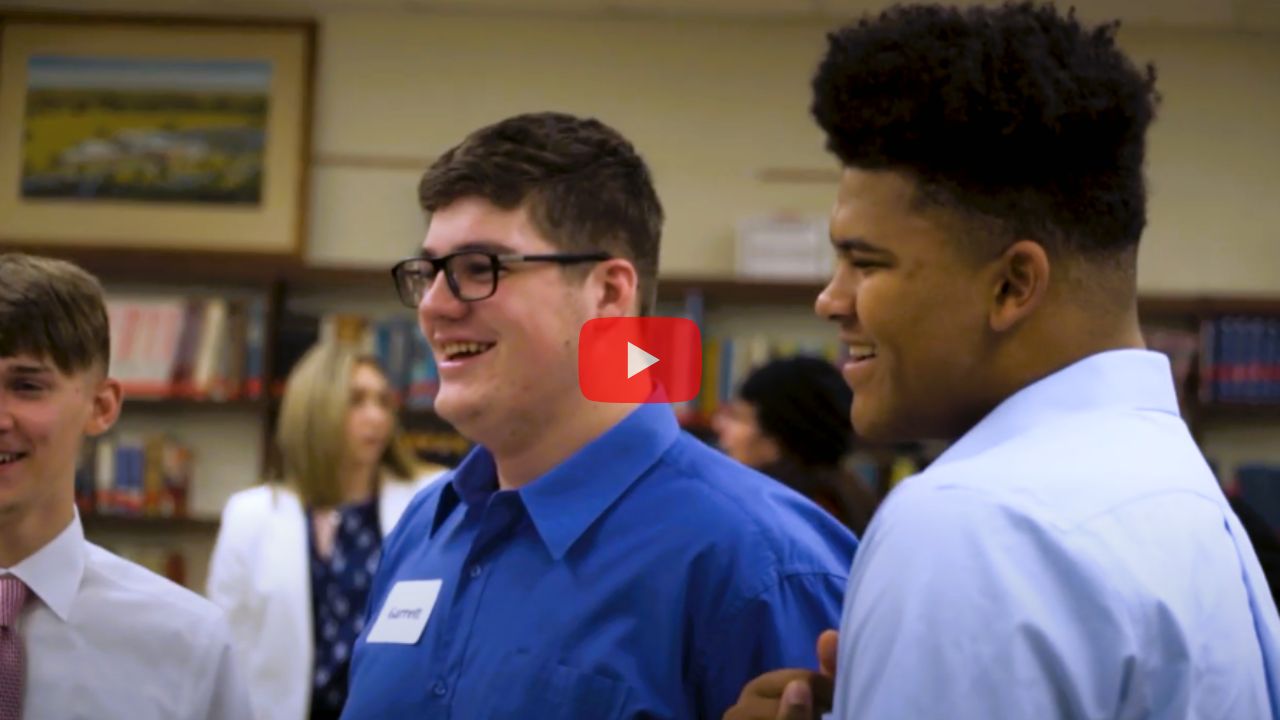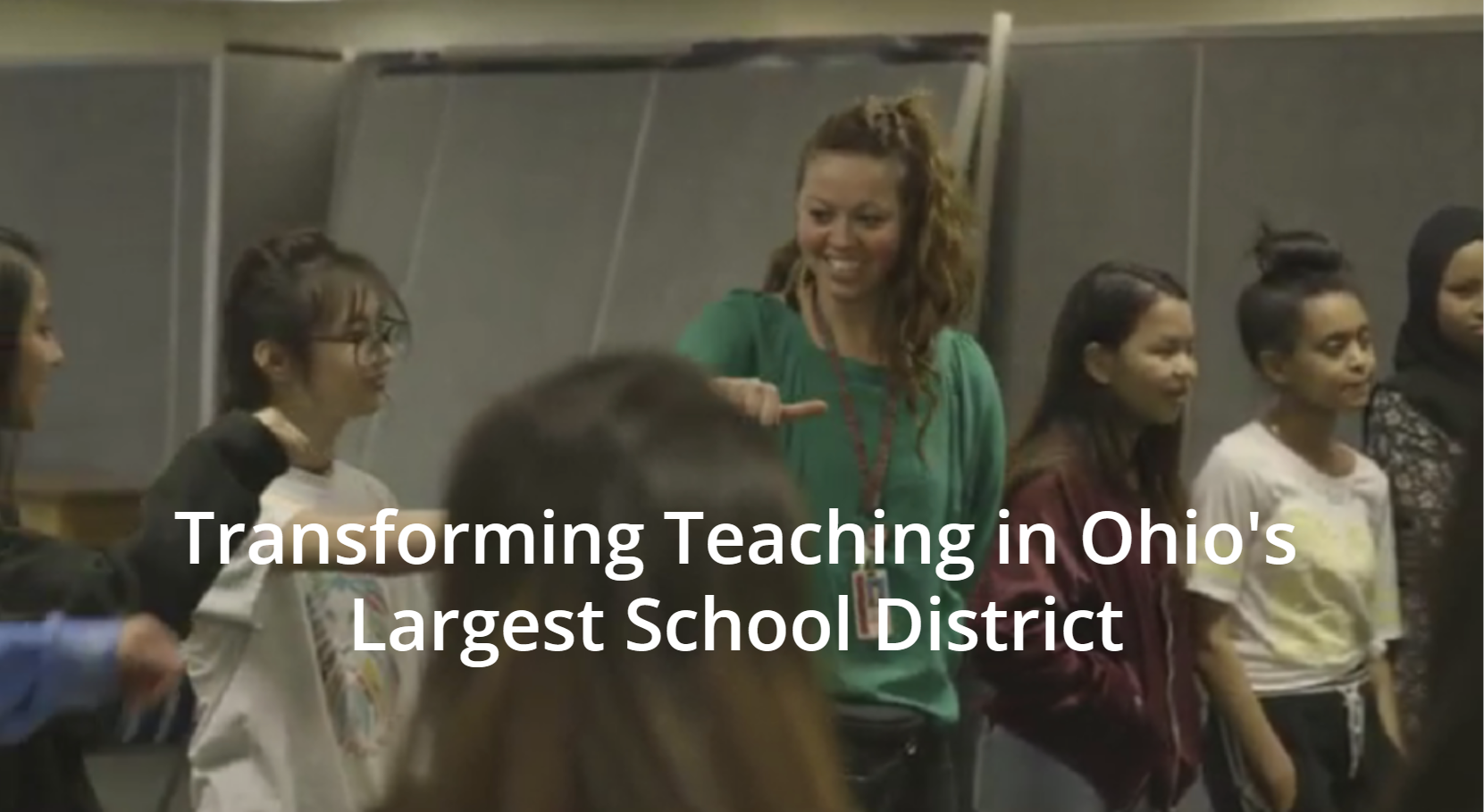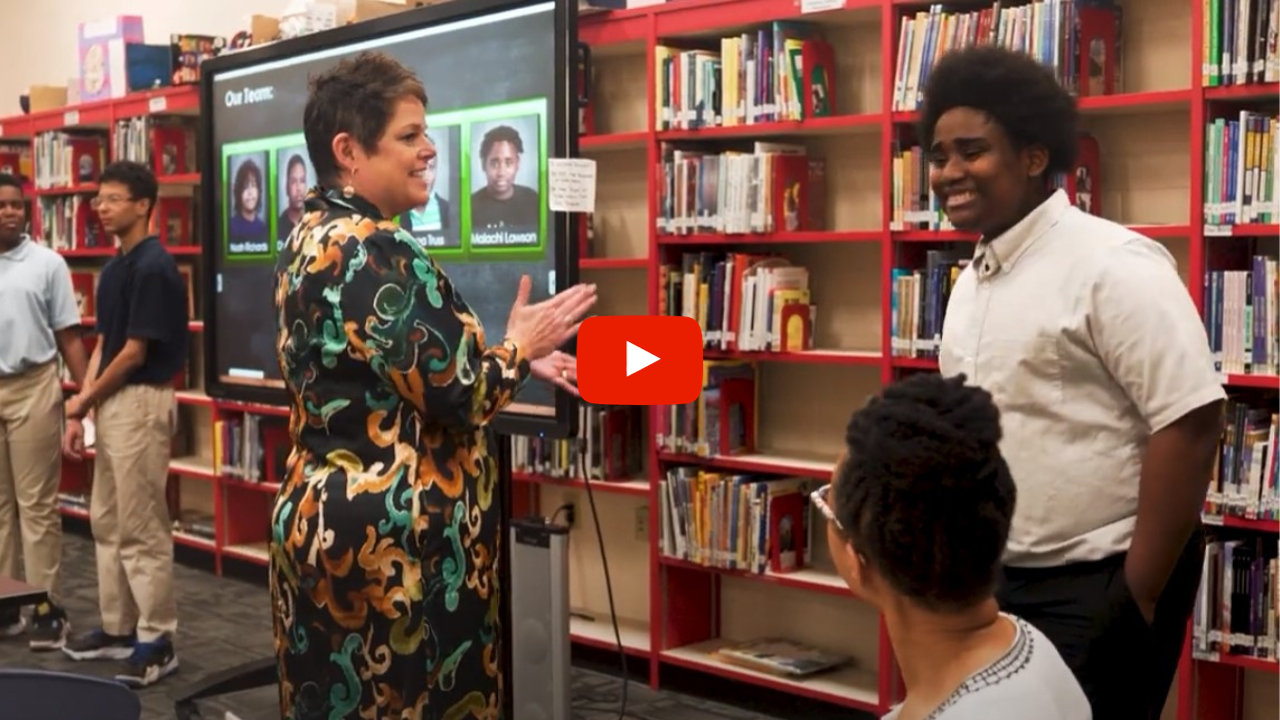In this episode, Tim and Alison discuss the different types of presentations students experience in this course. They also explain how students shift away from their inclination to prove mastery of content and to the presentation of a compelling story. They discuss the extraordinarily high quality of student presentations in this course and how that develops.
Alison: In the program, the students have to present a lot throughout the course, whether that’s just to the teachers initially in share-outs and then to their peers, eventually then to the community members and the CEO of the business.
Can you talk a bit about how you really get the students to develop those presentation skills not only verbally, but visually, how they’re designing the presentations and all of that?
Tim: Yes, definitely. There are varying levels of presentation, I guess we could call them. Early on, the kids are still trying to figure out, first, what the course is about, but they’re really grappling with the business problem that they’re facing. They’re so overwhelmed with the challenge that the idea of presenting at that point is pretty frightening to them.
So early on, we’ve started calling them more like share-outs. They are presentations, but they are not meant to be highly polished or really deep at that point. Pretty early on, they’re basically sharing with us what they know, what they’ve learned, sort of where they want to go.
Early on, they are very much consistent with what you would see in any type of classroom presentation. There are misspellings, formatting errors, there’s a lot of black text on white background, there are a lot of stock photos with the watermark still on them in the middle of the slides, you know, everything that you would expect high school students to do in a presentation.
The presentations themselves are usually pretty brutal to sit through. They either meander or there’s one student in particular who may be dominant and not create room for the others, or it may be designed that way. They may have a team and they say, “Wow, Joey, you’re our great presenter. You should go and sort of present this whole thing.”
So that’s kind of how they start out. What we’re working towards at the end, as you saw, is a final presentation that does have polish, that is well-rehearsed, but still passionate; a presentation that they can feel comfortable standing in front of not only a room full of their peers and their teachers, but people from the outside. That could be investors, that could be other local businesspeople, the CEO of the company or the startup that we happen to be working with. So the stakes get pretty high.
I think what’s sort of consistent about that, that’s consistent in our entire program is we don’t teach them those presentation skills. We don’t have a “presentation skills day” where we lecture on how to do presentations and they take notes. They learn by doing. They start out by doing them pretty terribly, and then hopefully by the end, they’re much better. So, like everything we do, it’s this idea of rather than prepare them, just go ahead and do it, and then you’ll learn from that.
Alison: I do remember, actually, in the first round of share-outs this semester, the critiques we gave back to the groups were very direct, as feedback tends to be. I remember specifically one group we mentioned, “Hey, that slide deck is pretty elementary. It really needs to be brought up to the next level,” and how they were shocked and slightly offended. They were, “What do you mean? This is what I always present.”
For them then to grow over the semester and have really much more sophisticated slide decks by the end, I don’t know if you want to share a little bit about your reaction?
Tim: Yeah. I remember exactly which team you’re talking about. They joked about it later on, how Mr. Desmond said mean things about our slide deck.
Alison: Yeah.
Tim: I think that’s something that this particular way of learning fosters is this transparency and this ability to be really direct with kids in ways that are meaningful and relevant. We’re not saying things to cut them down. We’re not saying things intentionally for any other reason other than we want them to get better. If we don’t give that kind of direct, honest feedback, they don’t know how to get better.
So I do distinctly remember that. Their next presentation was much better, if I remember.
Alison: That’s right. Absolutely. Yeah, the very next one out of the gate. And also to watch who steps into that role and to be able to see some of the team members as they’re moving through the three different business challenges start to try their hand a bit at the creative graphic design elements of a slide deck or how they best want to represent their ideas on the slide.
I’m curious if you have any examples of students you’ve worked with in past semesters who really sort of found their knack for creative design through the presentations?
Tim: There are two in particular who I remember. They didn’t necessarily discover their affinity for graphic design, but they really stepped into it and really recognized it as a strength and worked hard to make it even better. I think that’s something we see a lot, not necessarily with just graphic design, but this idea of students beginning to uncover who they are and then really kind of getting really good at that. That’s a really exciting thing to see.
We don’t let any kids off the hook. You can’t not present, right? The teams develop their own roles, especially in the presentations. You do get these kids who maybe were kind of goofing around with Photoshop and they knew a couple of things, but now they start applying that in this context and they really thrive, and that’s really exciting to see. I know there were a few in particular.
I wanted to ask you, I think one of your first interactions with our program before you came on board was seeing some of these final presentations. I wonder if you could talk about what impression that made on you from the outside, not knowing much about the program beforehand?
Alison: Sure. Yeah, that’s a good point, because I did come in expecting, okay, these are high school kids; we’ll see what they’ve got. I had come to one of each of the presentations, so the Business 1, Business 2, Business 3, and then their final presentations.
I remember it was in the Business 2 that I stepped back and I thought, “Wow, these kids must know a lot about how to use different elements in Google Slides or even PowerPoint.” That surprised me because I remember being in school and how basic – you keep the text box where it is and you just type in the bullets and all that.
I remember it was into the course a bit where they really started to understand the purpose of a presentation to be really a visual aid that has compelling statistics and validation points that help them tell their story.
The first business generally tends to be a report sort of style, whereas as you move forward, this is when we started to see slide decks with just one strong point or quote right in the center either in white or black font that was fairly sizeable and a large image thrown over the entire backdrop of the slide, where I thought, “Wow, they’re starting to understand the better ways to communicate their ideas,” that the entire purpose of having a slide deck up behind you isn’t to prove where they started it and having all these points and overwhelm the audience with all this data. Although sometimes they do, and sometimes that’s compelling, given what they’re specifically talking about.
For them to move to a place and to watch that growth I imagine – I was like, “Wow, they must be doing a lot on the back end.”
Tim: Yeah.
Alison: I did think that you were leading workshops or you had to be doing something to get the kids there. Now, after my first semester on the inside, I realize they just had to be in the trenches for a while and realize how poorly they were communicating first.
Tim: Yeah. Your point about having evidence on the slide I think is what – that’s how they come to us. I don’t think, I know this, because I’ve been a classroom teacher for a long time. I know in most student presentations, the understated or implicit demand on the student is prove your mastery of whatever this content knowledge is that we are studying, so the easiest way to do that is just to throw it all up on a slide and maybe even read from it.
And you, as a student, think, “Wow, look at that. I have seven PowerPoint slides up there. I’ve loaded them with stuff and I’m going to read all these bullet points to you. I think our kids quickly realize that anyone can do that and there’s nothing compelling about that. That’s almost a given. So we’re taking them from where they think is mastery and saying, “No, that’s your starting point. Now what you need to do is be able to communicate all that in a way that doesn’t bore people to tears. That’s the art of presenting.”
It’s not an exact science. It’s really hard to teach that, which is why I think doing it is a better way of learning it. I think you can probably attest to this, especially this last semester. We had one particular student who – I think you know who I’m talking about –who really made a really nice slide deck, and then the other teams started emulating that style. We never said that. It just naturally happened because they recognized the power in it. They could see it and they could feel it. That’s really cool when that kind of thing happens.
Alison: It certainly is. I remember talking to some people this semester after the presentations, those who were in the audience, the different people from the school community and more broadly, the local community, who came out to see the students. They specifically commented on how impressed they were that the students were not reading from a slide deck and were so familiar with their solution, with their material, everything they were suggesting, and that they were very off-the-cuff. So much so that in the Q&A with the CEO after their eight-minute presentation, they then have a few minutes for Q&A, that here, the entrepreneur asked them a question, and they’re able to just jump. They answered the question because they are that familiar. They even had some extra slides that they would flip to that I know always tends to wow some of the people in the audience who really don’t expect it out of high school kids.
Tim: Yeah, that was something that I remember Doris mentioning the first time, and I hadn’t thought of it before that. Then I saw it and I saw the effect it had on the audience, and especially the other teachers in the room.
If your students rehearse a presentation and they get up there and they just perform it as if they were delivering lines from a play, that’s one thing. But then to sort of not only anticipate what the questions are going to be, but then have slides to address those questions, that’s pretty impressive. I think the guys from Beam Dental were the ones that commented on that, that said, “We don’t see those kind of slide decks in the startup world, let alone from a bunch of high school kids.” They were really kind of blown away by that.
Alison: That’s the truth. That really is.
Tim: One thing we should mention that we didn’t touch upon in this conversation is the fact that these presentations represent just a small fraction of the wealth of information and things that they have uncovered and researched.
They only have a certain number of minutes, six to eight minutes, depending on the presentation, to present. Can you talk about the initial struggle students have with trying to get everything they want in, but knowing that they can’t?
Alison: Absolutely, yeah. This is where it starts to become a bit of an art form where the students are all racing to prove all of the research they’ve done and put as much detail into these presentations as they can, trying to divide out, well, you know, you did a bunch of research on this specific topic under our challenge, and you did a bunch on this, so you talk about that, and you talk about this, and only take 30 seconds, because we’ve got to get through to the next slide.
You start to see they’re almost racing through, not breathing, trying to cram as much as they can into these presentations. Initially, when they do this in a share-out format in front of their peers, they start to realize how ineffective that is. They aren’t able to really follow or be persuaded that whatever solution that team is suggesting actually makes any sense because they’re just trying to keep up. They’re just trying to follow through all these words on a slide and listen to multiple people racing through whatever they’re trying to persuade everyone to believe.
We do work with them a bit. I would say we push back on that a lot and over time, watch as they realize the importance of simplicity in a lot of ways, both from a storytelling perspective but also that notion of 80/20. When you’re sharing a lot of your initial proposed solutions to the CEO and the team, you give them a bit. You give them just enough. You give them that 20%. In reality, you have 80% behind the scenes ready to go. In the presentation, you start to see that when the CEO will ask a question during Q&A and the students have a whole heap of information to share out afterwards.
Also, we set up time after the presentations for the CEO and their team to sit down with the student teams one-on-one for a decent amount of time to let the students actually share their research. They generally write out significant reports and can really hand over a lot of market research to the CEO.
Having them make that distinction where when you’re presenting something and truly trying to tell a story so that people are compelled to listen and really believe in what you’re – I don’t want to say “selling” per se, but what you’re proposing, it’s a sophisticated place for them to have to move to. And really, an impressive skill that I know in the working world is not really refined for many people. To be able to watch high school students move there within three to four months through a course is pretty exciting.







